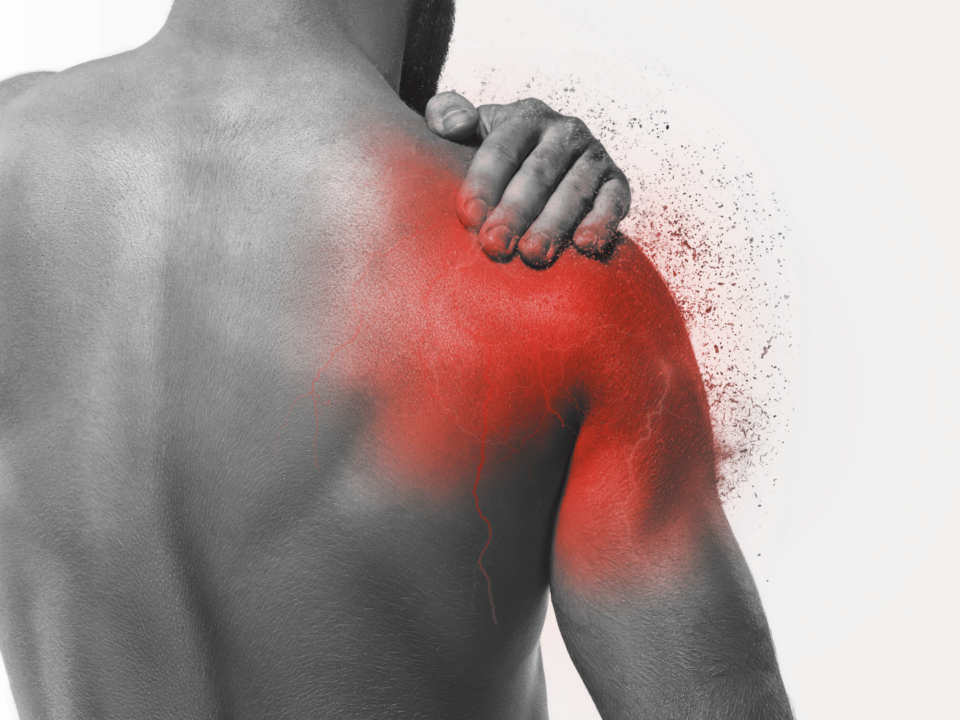
How to relieve rotator cuff pain at night: Expert tips for better sleep
April 14, 2025Have you ever felt a sharp, tight knot right between or under your shoulder blades that just won’t go away? That’s what many people describe as a muscle kink in the shoulder blade—a frustrating and often painful experience that can affect your posture, mobility, and even your sleep.
The good news? With the right information and strategies, you can relieve that muscle kink and prevent it from coming back.
In this article, we’ll explain the common causes of shoulder blade muscle kinks and share expert-backed relief tips to help you feel better fast.
Click here to learn more about pain management
What is a muscle kink in the shoulder blade?
A muscle kink, also known as a muscle knot or trigger point, is a tight, contracted area of muscle fibers that fail to relax. In the case of the shoulder blade area, the most commonly affected muscles include:
- Rhomboids (between the spine and shoulder blade)
- Trapezius (upper and mid-back)
- Levator scapulae (runs from neck to shoulder blade)
- Infraspinatus (on the back of the shoulder blade)
These knots can feel like a dull ache, sharp twinge, or deep tension. Sometimes, they even radiate pain to the neck, arms, or upper back.
What causes muscle kinks in the shoulder blade?
Here are the most common culprits:
1. Poor posture
- Slouching at your desk or leaning forward for long hours (tech neck)
- Rounded shoulders from phone or computer use
- Sleeping in awkward positions
2. Overuse or strain
- Repetitive lifting or pulling
- Intense upper-body workouts without proper stretching
- Carrying heavy backpacks or shoulder bags
3. Stress and tension
- Emotional stress often leads to muscle guarding or tension in the upper back and shoulders
4. Lack of movement
- Sedentary lifestyles reduce circulation and cause stiffness in muscles
5. Previous injury or muscle imbalance
- Old shoulder or neck injuries can cause compensatory tightness
- Imbalance between back and chest muscles pulls on the shoulder blade
Effective relief for a muscle kink in the shoulder blade
Here’s how to get rid of that stubborn knot and prevent future flare-ups:
1. Self-massage or trigger point release
Use your fingers, massage ball, or foam roller to apply pressure directly on the knot:
- Locate the tight spot (usually feels like a small bump or ropey band)
- Apply firm but tolerable pressure for 30–60 seconds
- Release and repeat 2–3 times a day
📌 Tip: Place a tennis ball between your shoulder blade and a wall, and gently roll over the knot.
2. Heat therapy
Applying heat helps relax tight muscles and increase blood flow:
- Use a heating pad, warm compress, or hot water bottle for 15–20 minutes
- Try a warm shower or bath focusing on the upper back
📌 Use heat before stretching or massage for better results.
3. Stretching exercises
Gentle stretches can release tension and improve flexibility:
✅ Shoulder blade stretch:
- Reach one arm across your body
- Use your other arm to pull it closer
- Hold for 20–30 seconds
✅ Child’s pose (yoga stretch):
- Kneel and extend your arms forward on the floor
- Lower your forehead and chest, feeling the stretch between the shoulder blades
✅ Cat-cow stretch:
- Get on all fours
- Alternate between arching and rounding your back slowly
4. Improve your posture
Good posture can prevent muscle kinks from forming in the first place:
- Sit with shoulders relaxed, chest open, and ears aligned over your shoulders
- Avoid hunching over phones or laptops—use a stand or ergonomic setup
- Take posture breaks every 30–60 minutes during long desk sessions
5. See a massage therapist or physiotherapist
If your muscle kink is chronic, painful, or not improving with self-care, it may be time to get professional help.
A massage therapist can:
- Target trigger points and deep muscle tension
- Promote relaxation and improve blood flow
A physiotherapist can:
- Assess muscle imbalances or mobility restrictions
- Provide manual therapy and personalized exercises
- Offer tools like dry needling, ultrasound, or electrical stimulation
6. Stay active
Movement is medicine. Gentle physical activity like walking, swimming, or yoga can prevent stiffness and reduce stress, two major causes of shoulder blade tension.
When to see a doctor
Consult your healthcare provider if:
- The muscle kink lasts more than 1–2 weeks
- You experience numbness, tingling, or weakness
- Pain radiates into your arm or chest
- You have difficulty breathing or sudden severe pain (to rule out cardiac causes or lung issues)
Final thoughts
A muscle kink in the shoulder blade can be painful, but it’s usually not serious—and often responds well to self-care. By incorporating stretching, heat, posture correction, and massage, you can find fast relief and keep those knots from coming back.
If your pain is persistent or affecting your daily life, don’t hesitate to seek help from a registered therapist. With the right support, your shoulders can feel looser, lighter, and pain-free again.
FAQs
What does a muscle kink in the shoulder blade feel like?
It often feels like a tight knot, dull ache, or sharp pinch between or under the shoulder blades.
Can stress cause shoulder blade knots?
Yes. Stress often leads to muscle tension, especially in the upper back and shoulders.
Is it okay to massage a muscle knot?
Absolutely. Gentle pressure can help release the tight fibers and improve circulation.
How long does it take to get rid of a muscle kink?
With proper care, most resolve in a few days to a week. Chronic knots may take longer.
Can poor posture cause shoulder blade pain?
Yes. Slouching or forward head posture strains the muscles around the shoulder blades.
Medical Disclaimer
The information provided in this article is for informational purposes only and should not be considered a substitute for professional medical advice, diagnosis, or treatment. Always seek the advice of your physician or another qualified health provider with any questions you may have regarding a medical condition or treatment. Never disregard professional medical advice or delay in seeking it because of something you have read in this article.




